- Home >
- News & Media > LATEST RESULTS: Annual Victorian Self-Driving & Electric Car Survey
LATEST RESULTS: Annual Victorian Self-Driving & Electric Car Survey

In late 2024, EastLink conducted its eighth Annual Victorian Self-Driving & Electric Car Survey, gathering insights from over 5,700 motorists who use Melbourne's EastLink.
This comprehensive annual survey, the largest of its kind, sheds light on evolving vehicle power preferences, barriers to electric vehicle (EV) adoption, and perceptions of self-driving technology.
Such insights are useful to automotive manufacturers, policymakers, researchers and others. Understanding motorists’ attitudes can help with addressing their concerns and improving the user experience with new technologies.
Summary of Key Findings
Vehicle Power Preferences:
Hybrid Electric: a record high 51% of motorists now prefer hybrid electric for their next vehicle, up from 46% in the previous two years.
100% Electric: Preference for fully electric vehicles has declined to 30%, continuing a downward trend from a peak of 42% two years ago.
Petrol and Diesel: Preferences for petrol (31%) and diesel (15%) have remained steady, confirming the increase from their low points two years ago.
Barriers to Electric Vehicle Adoption:
Purchase Cost: The primary barrier, though decreasing, remains the purchase cost (62%).
Charging Facilities: 58% of motorists cite the lack of charging facilities away from home as a significant barrier.
Vehicle Range: 52% are concerned about the range before recharging.
Government Incentives:
50% of motorists believe that government incentives are necessary to encourage electric vehicle adoption, with a preference for incentives that reduce the upfront purchase price and annual registration costs. This is significantly lower than the peak of 74% three years previously.
Driver Assist Functions:
Usage of a wide range of driver assist functions is continuing to increase every year.
The exceptions are active parking assistance and automatic lane changing, which are much less frequently used than other driver assist functions.
Self-Driving Vehicles:
Following years of decline in desirability of self-driving technology across a wide range of use cases, this survey now indicates a small bounce upwards in desirability of self-driving technology for each use case.
However, desirability remains well below 2017 levels across all of these use cases.
Do these small upward bounces in desirability indicate that motorists’ expectations are passing the Gartner Hype Cycle’s “Trough of Disillusionment” and are now in transition towards the “Slope of Enlightenment” when it comes to self-driving vehicles?
Connected Cars:
While there has been a small decline in desirability for vehicle connectivity over the past few years, a majority of motorists continue to desire connectivity for traffic warnings, road condition warnings, and vehicle security applications.
EastLink is a founding member of CCAT
EastLink is proud to be a founding member of CCAT (Centre for Connected and Automated Transport). As the findings show, there is still much to be done to bring the public along for the journey when it comes to self-driving technologies in particular. We support CCAT’s work as a champion in this space.
Electric vehicles

51% of motorists now include hybrid electric in their power preferences for their next vehicle (up from 46% in the previous two years).
However, just 30% of motorists now include 100% electric in their power preferences, which continues the decline in this power preference (from 42% two years ago and 34% last year).
The preference for petrol has remained steady at 31% (above its low point of 24% two years ago), and the preference for diesel has also remained steady at 15% (above its low point of 12% two years ago).
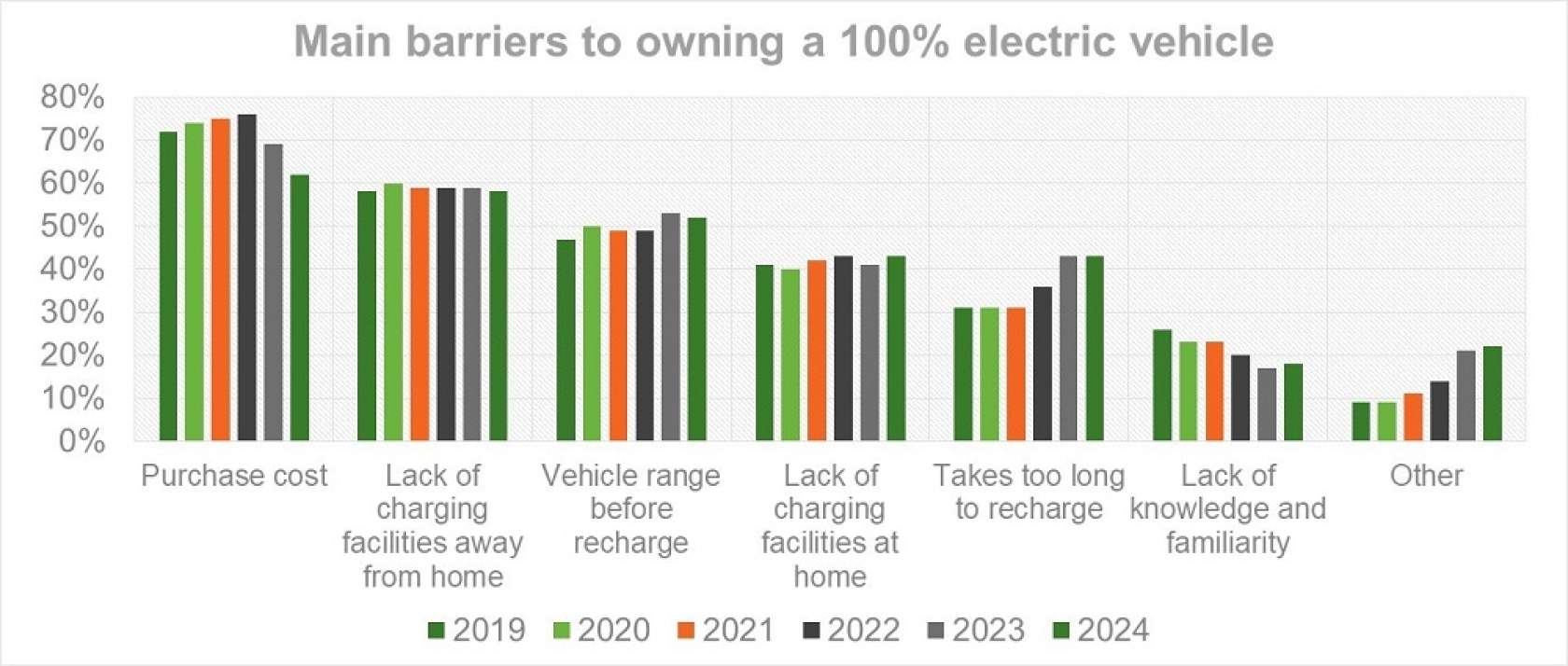
The main barriers to owning a 100% electric vehicle are: purchase cost (62%, down from 69% in the previous year and a peak of 76% two years ago), followed by the lack of charging facilities away from home (58%, unchanged since 2019), and then vehicle range before re-charging (52%, up from 47% since 2019).
Price reductions for established electric vehicle models and the introduction of new models with even lower costs are continuing to reduce the purchase cost barrier.
Driver assist functions

More and more motorists each year are using the latest driver assist functions.
The exceptions are active parking assistance and automatic lane changing, which are not used much, and for which usage is only slowly increasing.
Fully self-driving cars
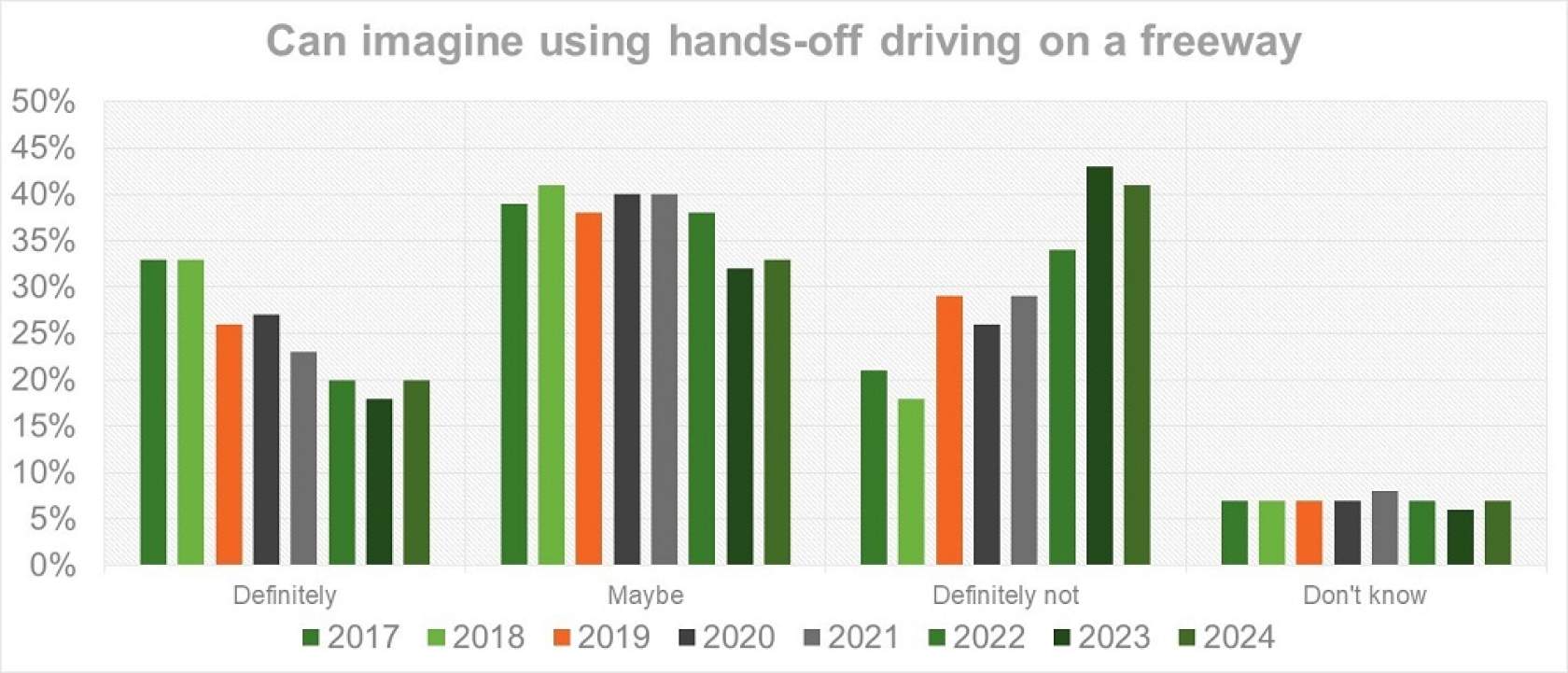
The proportion of motorists who say they could “definitely” imagine using hands-off driving on a freeway has bounced up slightly following years of decline.
Similarly, the proportion of motorists who say they could “definitely not” imagine it has reduced by the same amount.
20% can now “definitely” imagine it, compared to 41% who can “definitely not” imagine it.
However, despite this upward bounce in those who could “definitely” imagine using hands-off driving on a freeway, the most recent data remains well below the 2017 survey, when 33% could “definitely” imagine it.
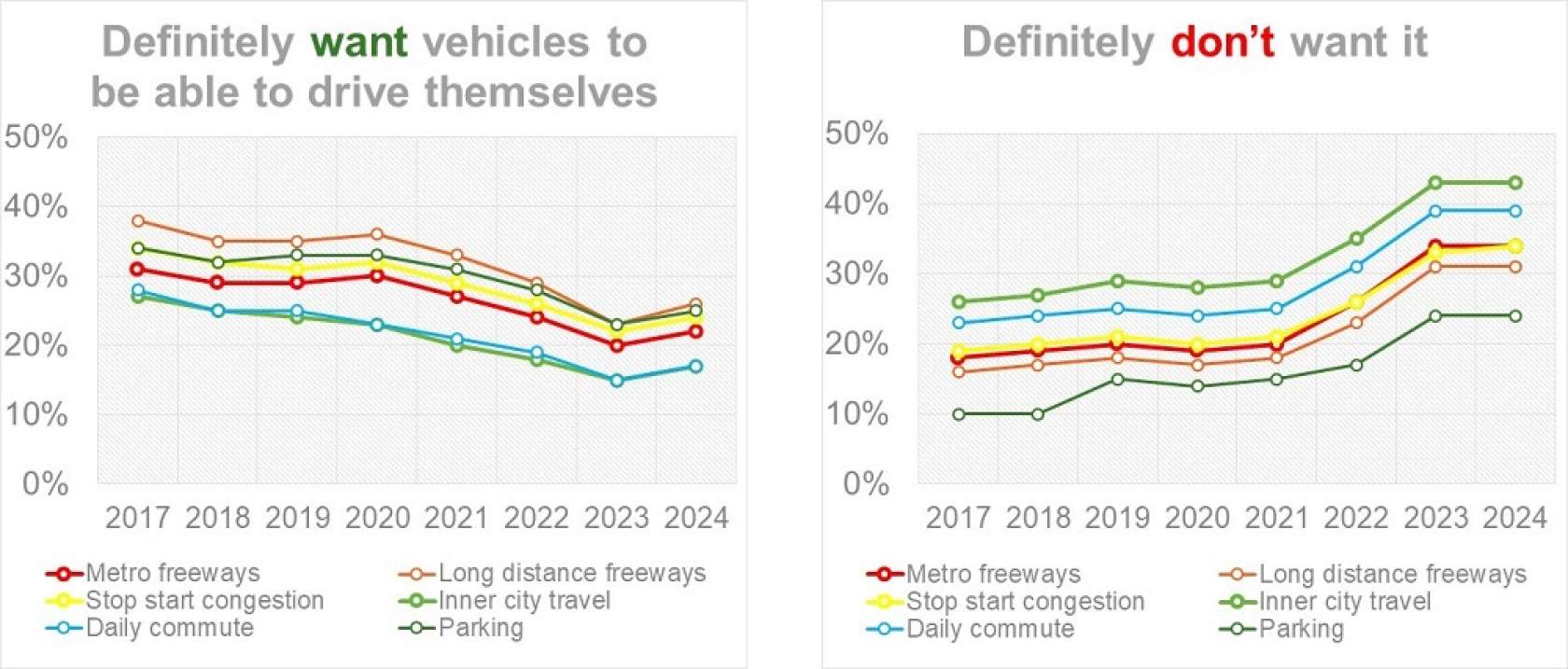
The proportion of motorists who say they “definitely want” vehicles to be able drive themselves across a wide range of journey use cases has bounced up slightly following years of decline.
However, despite this upward bounce, the most recent data remains well below 2017 data.
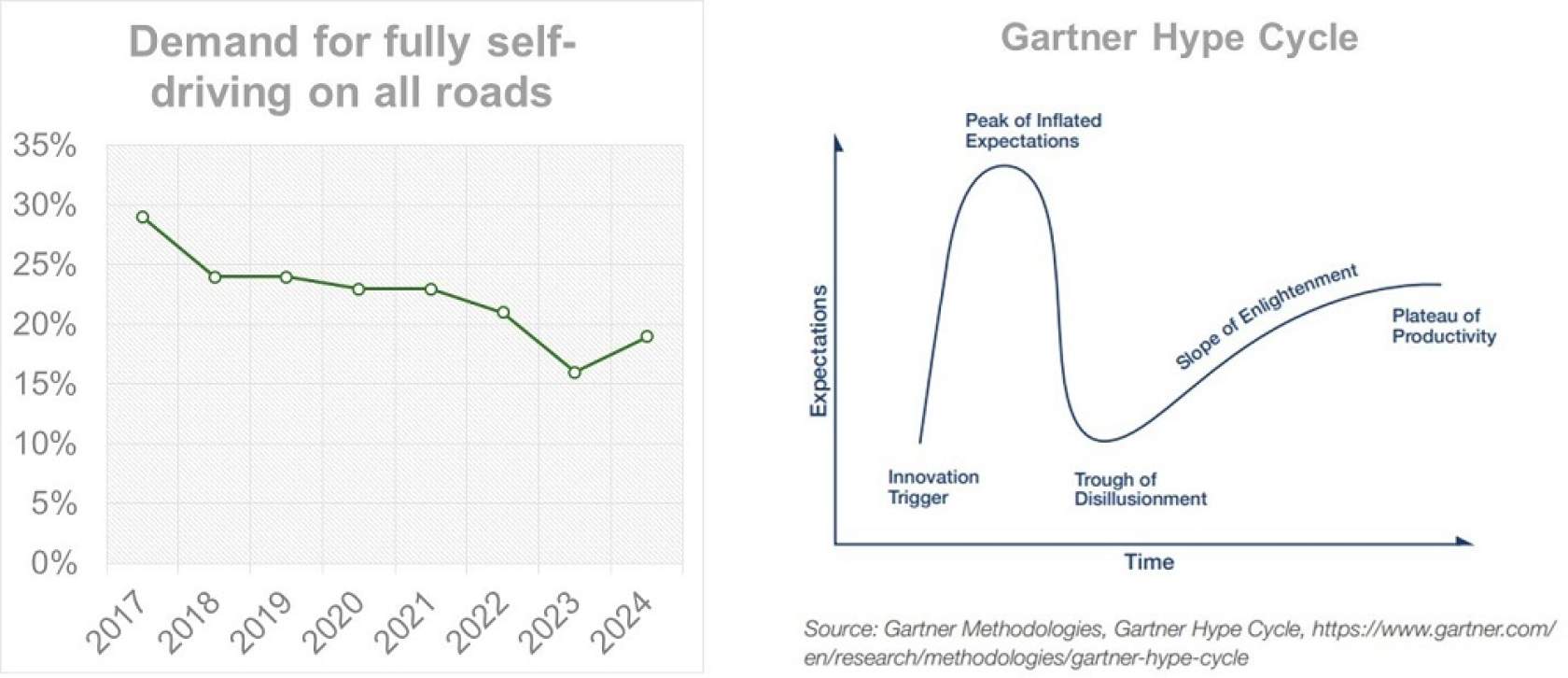
The proportion of motorists who want their next vehicle to offer fully self-driving on all roads has bounced upwards following years of decline.
19% of motorists now want it, compared to 16% in the previous year.
However this is still much lower than the 29% result from 2017.
Together with the other results in the survey outlined above, do the small upward bounces indicate that motorists’ expectations are passing Gartner’s “Trough of Disillusionment” and in transition towards the “Slope of Enlightenment” when it comes to self-driving vehicles?
Gartner explains parts of its Hype Cycle as follows:
Trough of Disillusionment: Interest wanes as experiments and implementations fail to deliver. Producers of the technology shake out or fail. Investments continue only if the surviving providers improve their products to the satisfaction of early adopters.
Slope of Enlightenment: More instances of how the technology can benefit the enterprise start to crystallize and become more widely understood. Second- and third-generation products appear from technology providers. More enterprises fund pilots; conservative companies remain cautious.
Plateau of Productivity: Mainstream adoption starts to take off. Criteria for assessing provider viability are more clearly defined. The technology's broad market applicability and relevance are clearly paying off.
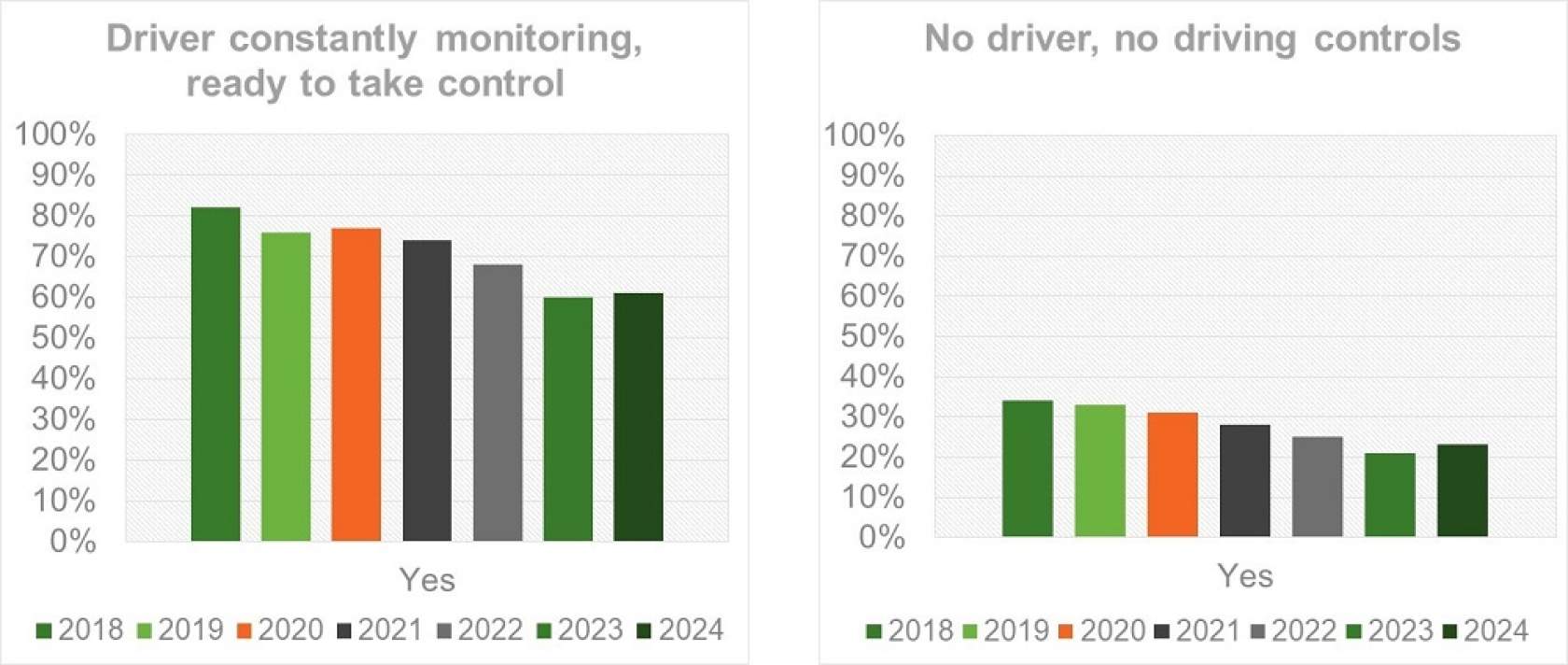
The number of motorists who would travel as a passenger in a fully self-driving car on a freeway has bounced up slightly following years of decline.
This is slight upward bounce is evident for both scenarios:
where the vehicle has a driver who is monitoring and able to take over control
where the vehicle has a driver who is monitoring and able to take over control.
While 61% would now travel in a fully self-driving car on a freeway where the vehicle has a driver who is monitoring and able to take over control, this falls to just 23% where the vehicle has no driver and no driving controls.
Connected cars
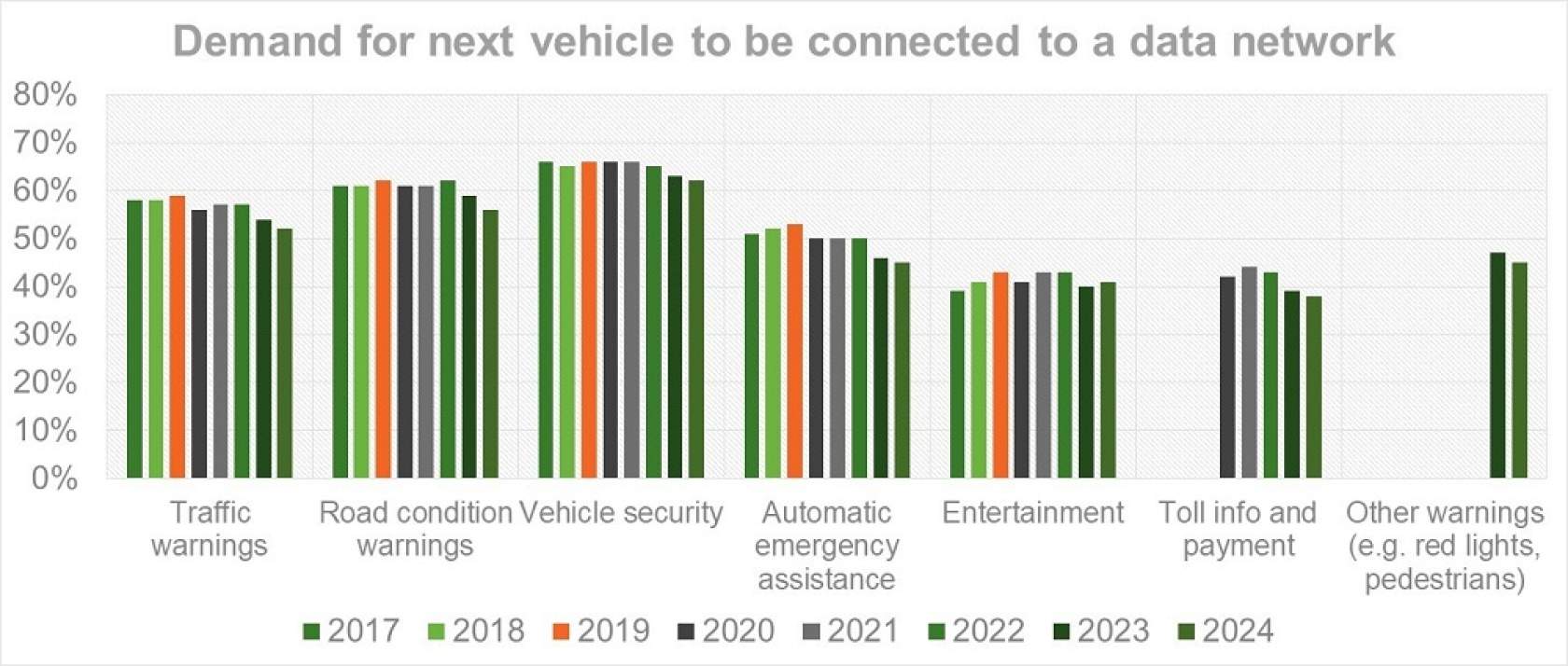
While there has been a small decline in demand for vehicle connectivity over the past few years, a majority of motorists continue to “definitely want” their next car to be connected to a data network for traffic warnings, road condition warnings and vehicle security applications.
45% of motorists “definitely” want their next car to be connected to a data network for other warnings (e.g. red lights, pedestrians).
45% motorists “definitely want” their next car to be connected to a data network for automatic emergency assistance.
Four in ten motorists “definitely want” their next car to be connected to a data network for entertainment as well as toll information and toll payment.
